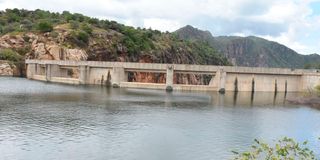Silver lining: Heavy rains have cut power costs, says Kengen

Turkwel Dam in West Pokot County.
The Kenya Electricity Generating Company (KenGen) says it is taking advantage of the heavy rains in the country to provide cheaper electricity to Kenyans.
Kengen managing director Peter Njenga said the firm is also using other means to supplement hydropower generation.
The company is working closely with stakeholders to develop cost-reflective tariffs that support a profitable 24-hour economy, rural electrification and the industrial and digital revolution.
Mr Njenga said that the ongoing rains play a critical role in the realisation of this commitment.
“To us, this abundance of water translates directly into more electricity available for Kenyans, further aligning with our goal of ensuring accessible and cost-effective electricity for all,” said Mr Njenga.
He explained that hydro is the cheapest source of electricity in Kenya, so the more you generate, the lower the overall cost of electricity to the off-taker, which is Kenya Power, and therefore to the customer.
“We have contained this water and at the same time use it to generate electricity for the benefit of Kenyans. We are actually playing a great role by ensuring that whatever we are able to generate with the available water levels, we are able to do it at the maximum capacities possible,” said Mr Njenga.
In the Western Region, for example, KenGen has increased its hydro generation at the Sondu and Sangoro power stations due to increased rainfall. The same applies to Turkwel.
The company is embarking on a number of projects to increase generation capacity.
Kengen has secured the necessary approvals for a 42.5-megawatt Seven-Fork Solar PV project and is currently completing the initial project preparation work. We are now ready for the construction phase of the project.
“This project is going to complement hydro during the day when the sun's intensity will be high, especially during the dry seasons. That way, we can conserve water for power generation mostly at night,” said Mr Njenga.
12th G2G Innovation Seminar
Mr Njenga was speaking at the 12th G2G Innovation Seminar in Kisumu alongside Kengen Chairman Julius Migos Ogamba.
Mr Njenga's comments come at a time when the country is experiencing heavy rains that have caused flooding, death and destruction.
There are also growing fears that some dams may burst, causing more deaths.
But for Kengen, the dams have helped to manage rising water levels in most rivers, reducing the impact of flooding, especially downstream of the Tana River.
Mr Njenga noted that the Turkwel Dam is far from reaching its maximum capacity, so there is no cause for alarm for the people living around it.
The dam is far from reaching its maximum height of 1,150 metres above sea level as it stands at 136 metres.
At present, the major hydroelectric dams in the Seven Forks have reached full supply capacity and now hold a combined volume of more than 2.6 billion cubic metres against a total flow of the Tana River estimated at five billion cubic metres.
Seven Forks dams
“This means that the Seven Forks dams hold the bulk of the water flowing from River Tana, way more than half the volume, which would otherwise be flooding areas downstream of the Dams thereby reducing the damage caused by the ongoing rains,” said Mr Ogamba.
In light of recent events, Mr Ogamba said the importance of prudent water planning cannot be overstated.
“We are particularly excited about the project to raise Masinga Dam by 1.5 meters, a move that will significantly enhance water management capabilities while addressing our growing energy needs,” said Mr Ogamba.
Mr Ogamba said the company was also in the process of expanding Gogo Power Station in the heart of Migori County from the current 2MW to 8.6MW.
The company is currently exploring new avenues to support the renewable energy agenda and ensure reliable power at minimum environmental cost through its Green Energy Park initiative by partnering with entities such as Konza Technopolis to attract industrial investors to benefit from sustainable and affordable energy solutions.
Plans for scalability
According to Mr Ogamba, the construction of the first 100 per cent green data centre is already underway, with plans for scalability to meet future demand.
This initiative not only supports our economic growth, but also aligns with the country's goal of achieving carbon neutral certification.
The company is leveraging robust geothermal capabilities to further harness the potential of renewable energy.
“We know we have a potential of 10,000MW of geothermal in the Great Rift Valley and this will form a big part of our strategy going forward,” said Mr Ogamba.
He says this is one of their most important stations at KenGen at the moment, promising growth at a time when capacity expansion seemed impossible.
As well as water management, the company is also involved in tree planting, with more than 350,000 seedlings planted last year alone.





